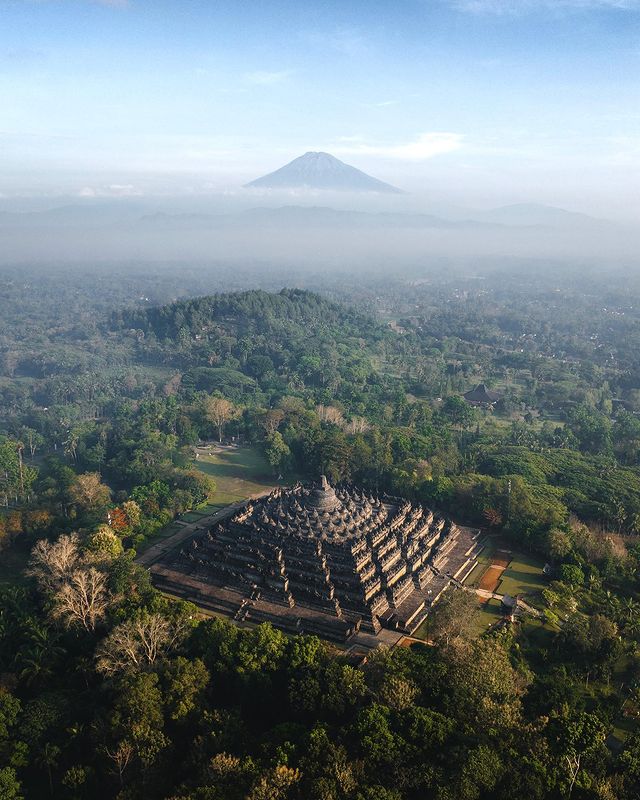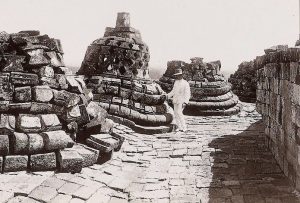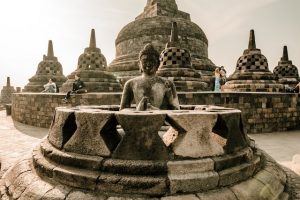
Enjoying One of the Wonders of the World, Borobudur Temple
Table of Contents

Visa Bali Info – Borobudur Temple Indonesia
The Indonesian Ministry of Tourism website states in its writing that the architectural splendor of Borobudur Temple cannot be separated from the long history of the development of Buddhism in Indonesia. The fame of Borobudur Temple is well known to foreign countries and is known as the largest Buddhist monument in the world.
Borobudur temple

Borobudur Temple is estimated to have been built around the 8th and 9th centuries AD in the era of the Syailendra Dynasty who was a follower of Mahayana Buddhism.
Experts estimate this temple was built in the 8th century. This estimate is based on a paleographic analysis of the writings carved on the Karmawibangga relief.
The relief depicting the cause and effect of good deeds at the foot of Borobudur Temple is compared to the writings on other inscriptions whose dates are known.
According to historian Peter Carey, Borobudur Temple at that time became a religious monument as a place of contemplation which also described the Buddha’s journey and at the same time became a symbol of the relationship between the king and his people.
Although until now, no written sources have been found that state exactly when the Borobudur Temple was built and how long the construction process took. Therefore, the age of Borobudur Temple cannot be determined with certainty.
Borobudur Temple Building

The Borobudur Conservation Center stated that the structure of the Borobudur Temple consists of nine terraces and a main stupa at the top. The nine terraces consist of six terraces with a square plan and three terraces with a circular plan.
Borobudur Temple was built using two million andesite stones from rivers around the temple area.
Altogether there are 504 Buddhas with meditative postures and six different hand positions throughout the temple.
A number of archaeologists suspect that the construction of Borobudur Temple underwent four renovations. Initially construction began by leveling the plains around the temple and compacting the soil with stones to form a pyramid structure.
The structure was later changed due to the addition of square and circular steps. Then, Borobudur underwent the final changes to the circular steps and the size of the foundation was widened.
It is not known exactly why Borobudur was abandoned by its inhabitants at that time. The theory of history leads to the eruption of Mount Merapi and the conversion of the population’s beliefs from Buddhism to Islam.
The news of the rediscovery of Borobudur was also a disaster for the destruction in many places. Until the late 1960s the Indonesian government asked UNESCO for help to overcome the problems at Borobudur Temple.
In the history of Borobudur Temple, its renovation took a long time and a huge expense until it was designated as a World Heritage Site by UNESCO in 1991.
Borobudur Temple Building Philosophy

Borobudur was built in the Mandala style which reflects the universe in Buddhist belief. The structure of this building is square with four entrances and a circular center point.
When viewed from the outside to the inside is divided into two parts, namely the natural world which is divided into three levels, including;
Kamadhatu
The natural world that is seen and is being experienced by humans now.
Kamadhatu consists of 160 reliefs that explain the Karmawibhangga Sutra, namely the law of cause and effect. Describing human nature and lust, such as robbing, killing, raping, torture, and slander.
Rupadhatu
The realm of transition, where humans have been liberated from the affairs of the world.
Rapadhatu consists of a gallery of stone relief carvings and Buddha statues. In total there are 328 Buddha statues which also have reliefs on the carvings.
According to Sanskrit manuscripts, this section consists of 1300 reliefs in the form of Gandhawyuha, Lalitawistara, Jataka and Awadana. The whole stretches for 2.5 km with 1212 panels.
Arupadhatu
The highest realm, the house of God.
Three circular porticoes lead to the central dome or stupa representing the resurrection from the world. In this section there are no ornaments or decorations which means describing the highest purity.
Functions of Borobudur Temple
Apart from being a tourist spot, Borobudur Temple now functions as a place of pilgrimage for Buddhists worldwide to guide humanity from worldly desires to enlightenment and wisdom according to Buddhist teachings.
History and brief information about Borobudur Temple may be useful for those of you who are going on vacation to this temple.
Always remember to maintain attitude and behavior, do not litter, throw cigarette butts into the statue stupa, perform acts of vandalism.
Bali Visa Agency : www.visa4bali.com – Experienced specialists managing the entire application process from start to finish





